The Impact of The Pollination Project (TPP) at the Heart of the World- The Sierra Nevada de Santa Marta
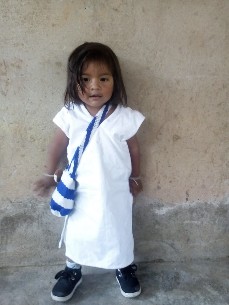 Thank you very much for inviting us to talk about magic, commitment, innocence, creativity and positive change. The humane quality and partnership with TPP continue making a difference in the Arhuaco Indigenous resguardo (reservation) since 2016 when we received the very first seed grant from this organization, enhanced by additional support from other two grants. Thank you, TPP, for helping The Great Balance (TGB) to serve a great community and a wise culture.
Thank you very much for inviting us to talk about magic, commitment, innocence, creativity and positive change. The humane quality and partnership with TPP continue making a difference in the Arhuaco Indigenous resguardo (reservation) since 2016 when we received the very first seed grant from this organization, enhanced by additional support from other two grants. Thank you, TPP, for helping The Great Balance (TGB) to serve a great community and a wise culture.TPP is making history in the Sierra Nevada de Santa Marta, Colombia (SNSM). Although the Arhuaco people have a profound sense of responsibility as caretakers of Mother Earth, and work on her protection and healing by dedicating 70% of their territory to conservation, there are still good many effective strategies they need to learn and practice in order to accomplish this goal more efficiently.
The One Million Tree Initiative has become critical in helping the Sierra in this task. Under the leadership of TPP and TGB we are forming an entire legion of volunteers and advocates for Mother Earth. We are advancing tree by tree, community by community, and person by person in creating a common effort, learning from each other and helping plants, animals, and the biosphere around the Heart of the World. Three years later, after our first seed grant, hundreds of little trees are growing in permanent sites, planted by little hands, old hands, female and male hands, with the blessing of the spiritual priests (the Mamos) and the spiritual work of the whole community.
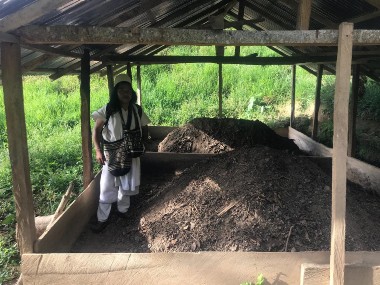 OMT is more than reforestation or recuperation of eroded sites. It is more than the fun of giving back the green cover to Mother Earth or working to help the Sierra to regain its pristine biodiversity. It is also, a new platform for passing knowledge and wisdom from one generation to the next. That is the case of the community of Gunsey, where the most honorable authority of the region, the Zakuco Mayor (highest, elder authority) Don Camilo Niño transforms himself on a story-teller to the 35 children in that school. Don Camilo has a folk story related to each tree species or the animals living in association with it and he tells these stories to the children while collecting and planting seeds. It is possible that Don Camilo won’t realize about this important and enchanted talent he has if the OMT won’t have invited him to share with the youngsters his stories.
OMT is more than reforestation or recuperation of eroded sites. It is more than the fun of giving back the green cover to Mother Earth or working to help the Sierra to regain its pristine biodiversity. It is also, a new platform for passing knowledge and wisdom from one generation to the next. That is the case of the community of Gunsey, where the most honorable authority of the region, the Zakuco Mayor (highest, elder authority) Don Camilo Niño transforms himself on a story-teller to the 35 children in that school. Don Camilo has a folk story related to each tree species or the animals living in association with it and he tells these stories to the children while collecting and planting seeds. It is possible that Don Camilo won’t realize about this important and enchanted talent he has if the OMT won’t have invited him to share with the youngsters his stories.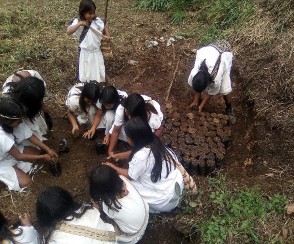 This initiative has helped the Arhuaco to realize that working together for saving their damaged land, make a difference in restoring the world that their ancestors had for living in peace and harmony. Most of the OMT projects started at elementary schools, which are also the centers of gathering for each local community as the Arhuaco do not build villages. Women and children are the most enthusiastic participants.
This initiative has helped the Arhuaco to realize that working together for saving their damaged land, make a difference in restoring the world that their ancestors had for living in peace and harmony. Most of the OMT projects started at elementary schools, which are also the centers of gathering for each local community as the Arhuaco do not build villages. Women and children are the most enthusiastic participants.OMT is also bringing leaders, teachers, authorities, Mamos, children and parents together to work and to join efforts in giving back to Mother Earth her natural vegetation. Since the beginning of this initiative, The Great Balance decided to honor TPP by creating specific guidelines to be observed by each participating community, including the prohibition of use of non-biodegradable materials in any aspect or activity of the project, not using any domestic animals, protect and care for their dogs and to send virtual reports assisted by The Great Balance coordinator in the Sierra. Through this intervention, we are reinforcing care for the environment as community members become aware of the importance of recycling and banning the use of plastics.
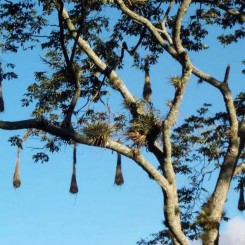 Today most of the participating communities of the OMT initiative are doing compost and recycling. Communities have different projects for planting trees, all of species endemic to the Sierra, for different purposes. Some efforts are focusing on the protection and recuperation of the hydrological watersheds, others are planting to provide food and nesting for wildlife. Some communities are planting trees to provide the traditional materials that Mamos use in their traditional spiritual work with all Indigenous communities.
Today most of the participating communities of the OMT initiative are doing compost and recycling. Communities have different projects for planting trees, all of species endemic to the Sierra, for different purposes. Some efforts are focusing on the protection and recuperation of the hydrological watersheds, others are planting to provide food and nesting for wildlife. Some communities are planting trees to provide the traditional materials that Mamos use in their traditional spiritual work with all Indigenous communities.Our new initiative deals with creating medicinal gardens at different thermic levels in the SNSM to establish a network of these gardens in different parts of the Sierra. A great advantage of this initiative is to invite the elementals associated with each medicinal species to enhance the healing power of these plants. Along with this activity there is a new project of creating traditional schools of healers and their related practices. In addition, TGB has a project for studying their medicinal plants for offering their traditional knowledge to other parts of the Sierra, including the colonos (the local agriculturists) living in the lower parts of the mountain.
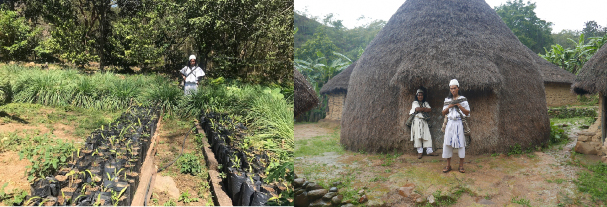
We are also seeing an effort from the community of Jimain to cultivate an important natural resource, the bitter palm, Sabal mauritiiformis, an important resource in the Sierra. The tribes of the SNSM use the leaves of this palm for thatching their huts and building the walls and roofs of their sacred temples, also known as Kankurwas. As we mentioned in a previous report to TPP, due to the high demand for this palm across the Sierra and the Caribbean coast of Colombia, its population has declined to about 90% of its original distribution.
The bitter palm is a resilient species, easily adaptable to disturbed environments and it is growing well in Jimain. Other communities are working to protect other wild endemic species of plants and animals, medicinal plants, and plants with fibers and wood that are used for building musical instruments, arts and crafts.
At the moment, we have four new communities who have joined us on the OMT initiative:
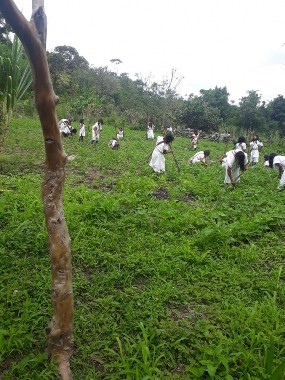 Jimain, a community with 105 volunteers.
Jimain, a community with 105 volunteers.Simonorwa, two communities: one of the schools is the Indigenous Elementary school of Simonorwa. In this school more than 135 kids, their parents and teachers are working on the food production as well as cultivating plants providing materials for traditional and spiritual work. These activities are an essential part of the tribal life enabling the exchange of knowledge and the maintenance of spiritual, social and environmental cultural values. This is also a platform for an open classroom to learn about traditions from ancestral practices of knowledge and wisdom. These activities are helping the indigenous elementary school to produce their own food, planting endemic seeds (kias), identifying and caring for important species in the maintenance of their biodiversity and uniqueness of the Heart of the World. The community of Kanuteti has 15 volunteers and its main leader is Mr. Francisco Arroyo. Mr. arroyo together with family and friends have planted about 600 trees of higuito (Ficus prinoides) a big tree with thick stem and strong branches. It is an endangered species from the Sierra and important one for the watershed protection. This is an interesting initiative given the fact that it is not easy to grow this tree from seeds, but Mr. Arroyo has planted 600 trees by cutting with a success rate of 50%.
Moroto is a community project leaded by Apolinar Izquierdo. He has planted about 2000 trees including a common, endemic species called aguacate macho (male avocado) which he is promoting it as a source of lumber. This huge tree grown easily by cutting. Its long branches can be cut from the tree and use as lumber. Its fruits are food for wildlife.
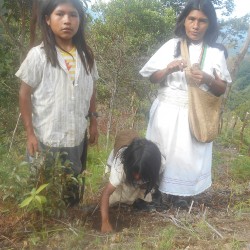 Rantachukwa, two communities working there under the leadership of two Mamos. Mamo Luis Eduardo Malo is reforesting an eroded area in this community. Mamo Luis Eduardo started this initiative with his wife and five children. They are reforesting a eroded hill near their house. In the words of Mamo Luis Eduardo: “The One Million Tree initiative, has brought a sense of community to our group of families in the region of Rantachukwa. It has encouraged several of our families to contribute in reforesting and composting and they have enjoyed the peacefulness and learning about caring for our natural resources. Today our elementary school is working with TGB in developing a new activity. We are extremely grateful to the Great Balance and The Pollination Project for all their support on this project.”
Rantachukwa, two communities working there under the leadership of two Mamos. Mamo Luis Eduardo Malo is reforesting an eroded area in this community. Mamo Luis Eduardo started this initiative with his wife and five children. They are reforesting a eroded hill near their house. In the words of Mamo Luis Eduardo: “The One Million Tree initiative, has brought a sense of community to our group of families in the region of Rantachukwa. It has encouraged several of our families to contribute in reforesting and composting and they have enjoyed the peacefulness and learning about caring for our natural resources. Today our elementary school is working with TGB in developing a new activity. We are extremely grateful to the Great Balance and The Pollination Project for all their support on this project.”The project, Mao Luis Eduardo is referring to is the Indigenous Rantachukwa, is the third one in that area at the elementary school with a medicinal plants garden. There are other participating communities in other regions no mentioned here. Those include, Kawar, Gunsey, Cobadonga and Pueblo Bello. Every year TGB organizes an annual meeting where the leaders and members of the participating communities attend and share their projects, ideas and challenges. This gathering is recognized by the Mamos and authorities as an important one organized by an outside institution. An additional impact of our project is their discovery that by mobilizing an entire community, they have an unexpected power to do things that reach beyond their “world”.
It is possible that this update does not fully reflect the journey that TGB and TPP have walked in the Sierra but it really is an extraordinary journey, reaching out to the heart of the Sierra, bringing back forest and the protection of the watersheds, not only of the SNSM but also of the many cities around this unique coastal massif. In conclusion, with the support of TGB and TPP, the OMT has help the Arhuaco communities of Heart of World to see themselves
As the traditional caretakers of Mother Earth who venerate their continuing sense of responsibility to preserve the spirit and stories of their ancestors throughout the landscape.
The Arhuaco and their sister tribes are the traditional custodians and caretakers of the land the Sierra Nevada de Santa Marta, Colombia. Their wisdom and shared responsibility to manage the natural resources in their environment is enhanced by discovering and sharing these new strategies of conservation.



